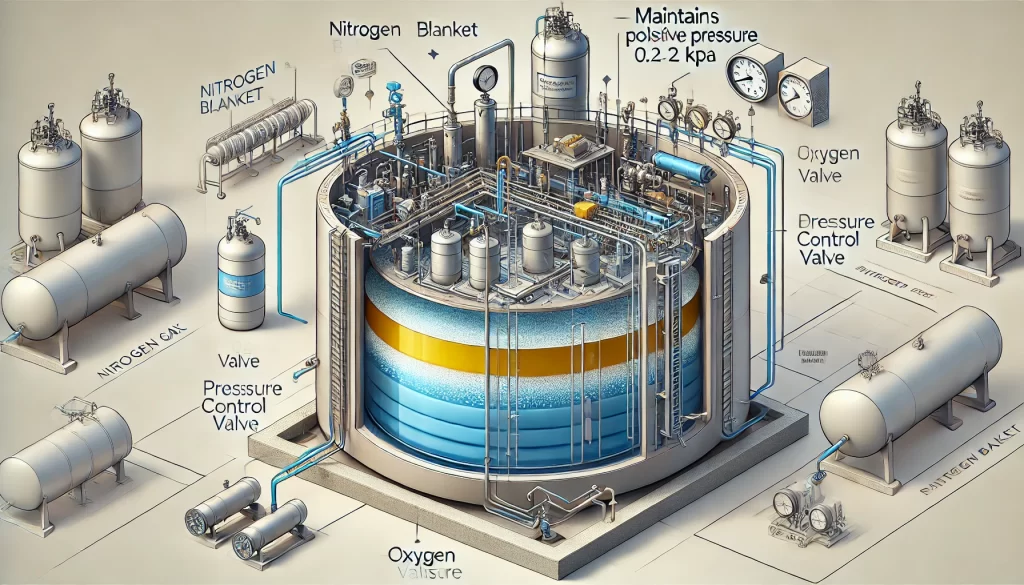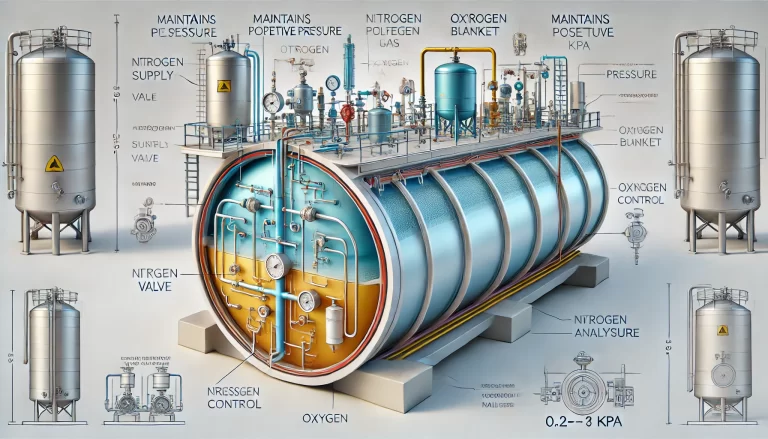Nitrogen blanketing is a protective technique widely used in industries such as chemical manufacturing, oil & gas, pharmaceuticals, and food processing. It involves the controlled introduction of nitrogen gas into a storage tank to maintain a slight positive pressure, providing multiple safety and quality benefits.
🔍 1. Key Functions of Nitrogen Blanketing
1.1 Prevent Oxidation and Degradation
Inert Gas Protection: Nitrogen, being an inert gas, displaces oxygen (O₂) in the tank, preventing oxidative reactions that can deteriorate stored materials such as chemicals, oils, or food-grade raw materials.
Inhibits Microbial Growth: The oxygen-free environment suppresses the growth of aerobic bacteria and molds, extending the shelf life of perishable or biological materials (e.g., edible oils, pharmaceuticals).
1.2 Reduce Evaporation and Vapor Loss
Minimizes Vaporization: By covering the liquid surface, nitrogen reduces the evaporation of volatile components (e.g., solvents, light hydrocarbons), thereby minimizing product loss and VOC emissions.
Balances Internal Pressure: Temperature fluctuations can cause expansion or contraction of tank contents. The nitrogen layer adjusts automatically via pressure control valves to maintain a slight positive pressure (typically 0.2–1.5 kPa), preventing air ingress and vapor leakage.
1.3 Improve Safety
Eliminates Explosion Hazards: For flammable materials like benzene, acetone, or LPG, nitrogen keeps the oxygen concentration below the combustion threshold (typically <5%), avoiding the formation of explosive mixtures.
Reduces Static Discharge: Nitrogen minimizes friction from gas movement, lowering the risk of static electricity buildup and fire.
1.4 Protect Equipment and Process Stability
Mitigates Corrosion: By isolating oxygen and moisture, nitrogen slows down internal corrosion of tank walls and piping—especially important when storing acidic or hygroscopic substances.
Maintains Process Conditions: In continuous processes (e.g., feeding reactors), nitrogen blanketing ensures stable tank pressure, promoting consistent and controllable material delivery.

⚙️ Key Components of a Nitrogen Blanketing System
| Component | Description |
|---|---|
| Nitrogen Supply | From a liquid nitrogen tank or nitrogen generator (purity ≥99.5%). |
| Pressure Control Valve | Automatically regulates nitrogen flow into the tank. Self-operated or solenoid-based. |
| Breather Valve | Releases or admits nitrogen during overpressure or vacuum conditions. |
| Monitoring Devices | Pressure gauges, oxygen analyzers, and alarms for real-time status tracking. |
📌 Suggested Illustration: Diagram of a nitrogen blanketing system with labeled components.
🧪 Typical Applications
Flammable Liquids: Gasoline, ethanol, acetone, solvents, and liquefied gases.
Oxidation-Sensitive Products: Edible oils, pharmaceutical intermediates, resin compounds.
High-Purity Chemicals: Electronic-grade solvents, precision reagents.
Environmental Control: Facilities needing VOC emission reduction.
⚠️ Important Considerations
Nitrogen Purity: Select purity based on material sensitivity. Highly reactive substances may require ≥99.9% purity.
Cost Efficiency: Nitrogen use adds operational cost. Optimize pressure settings and use efficient generators to reduce consumption.
System Maintenance: Regularly inspect valve seals, filter clogs, and instrument calibration to prevent leaks or contamination.

✅ Conclusion
Nitrogen blanketing offers critical protection in storage environments where safety, quality, and environmental control are essential. It effectively prevents oxidation, reduces vapor losses, minimizes explosion risks, and preserves the integrity of stored materials.
When designing a nitrogen blanketing system, it’s important to consider tank type, process conditions, and product characteristics to ensure optimal performance. Regular monitoring and preventive maintenance are key to long-term reliability.
